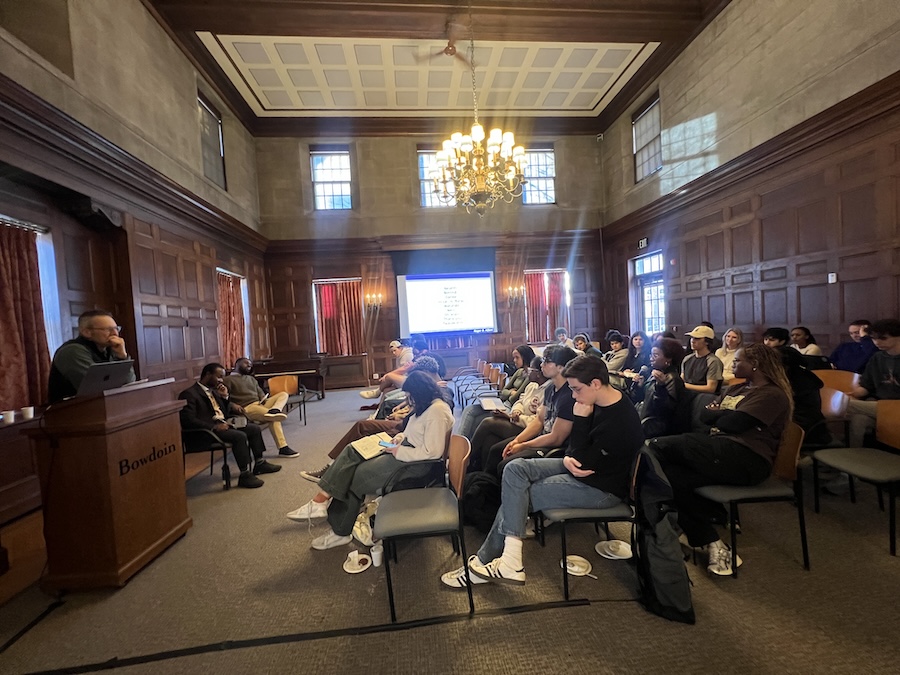Prof. Matthew Klingle on Flint Water Poisoning
By Tom PorterMatthew Klingle, associate professor of history and environmental studies, shares his thoughts on the ongoing water contamination crisis in Flint, Michigan, where lead started leaking into the public water supply nearly two years ago, after the city switched to a new water source. This water came from the Flint River and proved highly corrosive to the lead pipes through which it was pumped. Local residents have reported numerous health problems related to the lead contamination crisis.
What was your overall reaction to the Flint lead poisoning scandal?
The crisis in Flint is neither surprising nor unique. Cities across America face aging and crumbling infrastructure, plus understaffed and underfunded agencies responsible for keeping us safe. The situation in Flint is so dramatic because it brings together those problems with two other ongoing crises: the hollowing out of former industrial cities and the persistent problems of socioeconomic inequality. As many commentators have noted, the story of Flint is a story of environmental injustice: of environmental hazards being unequally borne by the poor and communities of color.

How widespread is the problem of lead water contamination?
The problem is that we don’t quite know. Leaded water pipes were banned over 30 years ago, but many older cities have pipes as old and compromised as those in Flint. The cost to update these aging systems is staggering—in the tens of billions at least—plus replacing old pipes means tearing up public and private property, often at great inconvenience despite the demonstrated health concerns.
There are also political objections to increasing the spread and influence of government regulation; last fall, both houses of Congress voted to reject an effort by the US Environmental Protection Agency to clarify its regulatory oversight of waterways that supply water for as many as one in three Americans. Although President Barack Obama vetoed this legislation, more than two dozen states are currently suing to prevent the EPA from exercising its authority.
Are any particular geographic parts of the country affected worse than others?
Older cities are most at risk, especially those that have water systems dating back to the 19th and early 20th century. So cities in the Northeast and the upper Midwest, places like southern Michigan, may be in greater danger. But given that most major U.S. metropolitan areas came of age at the turn of the last century, the risk is widespread, including all of the major cities in Maine. But the degree and probability of this risk is hard to assess. It depends on the chemical qualities of the water supply, which can corrode piping, or if construction or other activities disturb underground systems, leaving them vulnerable to exposed lead leaching into drinking water.
What needs to be done to stop this happening again?
First, acknowledging that the crisis in Flint is more than one of simple aging infrastructure. It is a story of environmental injustice, period. Flint had already been abandoned by the state of Michigan and the nation, beginning with the hollowing out of a once-proud industrial center in the 1980s with the departure of General Motors. De-industrialization accelerated the white flight and capital flight that compounded Flint’s decline. So by the spring of 2014, the decision to switch Flint’s water supply from metropolitan Detroit’s system to the local Flint River was made in the interest of saving money for a strapped city already in state receivership. It made economic sense if not ethical sense.
That switch started the corrosion in the pipes that yielded today’s newspaper headlines. And it seems that many in power knew that the switch was causing problems, even then. Recently released emails demonstrate that state officials and aides to Michigan Governor Rick Snyder downplayed the problem. So it strains credulity to think that a more prosperous community would have faced such problems or disregard. The evidence points to neglect, even perhaps malfeasance from city officials to state authorities, but that neglect has a long history behind it.
 Second, given the long history that led to Flint’s troubles, addressing the problem will be neither simple or inexpensive but it is becoming necessary. The potential public health effects will ramify for years to come. Lead is a pernicious and cumulative toxicant that affects multiple body systems. The health care costs alone could be significant; replacing the water system in Flint alone will be expensive enough.
Second, given the long history that led to Flint’s troubles, addressing the problem will be neither simple or inexpensive but it is becoming necessary. The potential public health effects will ramify for years to come. Lead is a pernicious and cumulative toxicant that affects multiple body systems. The health care costs alone could be significant; replacing the water system in Flint alone will be expensive enough.
One replacement project in Lansing, the state capitol and only an hour drive from Flint, has been underway since 2004 and estimated to cost approximately $42 million. But Lansing has a municipally-owned utility that provides water for a mid-sized city of about 115,000 residents. Other cities that have larger populations or get their water from private utilities may face greater challenges in updating their systems or installing safeguards. Plus, for many cities, maintaining current infrastructure is problem enough. The EPA estimates that $384 billion may be needed to cover deferred maintenance and protect America’s drinking water by 2030.
Finally, we need to realize that safe and sufficient water isn’t a commodity but a public good that needs to be protected. Lead is only one of many toxicants that imperil safe drinking water supplies around the nation. The US EPA has a list of almost 100 potentially hazardous chemicals under review for further regulation, plus about a dozen microbes that pose public health threats. But there are many more chemicals and organisms that the agency has yet to study. Legislative efforts to encourage further study into known and potential contaminants have been stymied in Congress. Funding cuts to state and federal regulators have hamstrung attempts to enact reform even with insufficient scientific knowledge and political backing. Flint is a warning, but we will see if Americans heed what we are learning from this tragedy. Time will tell if other cities—including more affluent ones—will face the same problems as Flint in the future. Unfortunately, without concerted action, they probably will.



